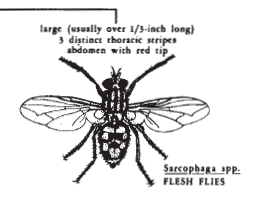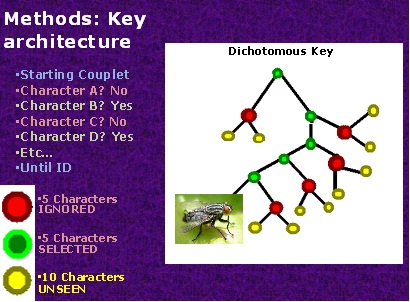INTRODUCTION
TO THE SARCOPHAGINAE:
The common name of flesh fly comes from the fact that the larvae of most species develop in spoiling meat and decayed flesh. Some species are beneficial because they are parasitic on arthropod pests. Because they develop in fecal material or garbage, some species are of human health concern. Some species can cause subcutaneous or intestinal myiasis in humans.
Females are larviparous or give birth to larvae/m aggots as well as laying eggs. Larvae are laid on the larval food material. Many species develop in excrement or decaying flesh, some are parasitic, and others can develop in a variety of materials. Pupation usually takes place in the top 51 mm of soil. The life cycle (adult to adult) varies with the species, with a range of 8-36 days.
aggots as well as laying eggs. Larvae are laid on the larval food material. Many species develop in excrement or decaying flesh, some are parasitic, and others can develop in a variety of materials. Pupation usually takes place in the top 51 mm of soil. The life cycle (adult to adult) varies with the species, with a range of 8-36 days.
RECOGNITION:
Adults are usually range between 2.5-26 mm long; and are relatively large, robust
flies. From far, they are a dull blackish gray; their eyes are often reddish; the thorax is
usually with three black longitudinal stripes; and the abdomen is often a checkerboard pattern of black and gray spots, whose markings shift from dark to pale depending on the viewing angle. The tip of the abdomen is usually red or pink. They are easy to confuse with house (Musca domestica) and face (M. autumnalis) flies, which have a thorax with four dark longitudinal stripes, and an abdomen lacking the black and gray checkered pattern.
INTRODUCTION TO DIGITAL KEYS:
In a conventional, dichotomous key, the user starts at the root of the tree, and follows the branches corresponding to the character states exhibited by the specimen until the taxon name is reached, missing  several characteristic states in the process. A mistake made by the user in assigning a characteristic state to the specimen inevitably leads to a wrong identification. When a conventional key is being used, the only way to recover from a wrong identification due to mistakes by the user is to backtrack to the node where they guess the error was made and try following another branch, see picture below. If the error is in the key itself (i.e., an error in key design, by the author), recovery is not possible.
several characteristic states in the process. A mistake made by the user in assigning a characteristic state to the specimen inevitably leads to a wrong identification. When a conventional key is being used, the only way to recover from a wrong identification due to mistakes by the user is to backtrack to the node where they guess the error was made and try following another branch, see picture below. If the error is in the key itself (i.e., an error in key design, by the author), recovery is not possible.
An interactive key is an interactive computer program in which the user enters attributes (characteristic-state values) of the specimen. The program eliminates taxa whose attributes do not match those of the specimen. This process is continued until only one taxon remains. This means that the user can select as many or as few character states as they like and make a selection from the “remaining entities” window.
Identifly 2: South African Sarcophaginae is hosted at http://keys.lucidcentral.org/key-server/player.jsp?keyId=65.
INTRODUCTION TO THE POST-ABDOMINAL SCLERITES:
The identification of species within this subfamily is most reliably based on examination of the characters of the male genitalia, as in below. Identifying flesh flies is generally recognized as a difficult challenge because the group is rather uniform in its external morphology. In Identifly 2, you will need to be able to recognize the features on the next page. In all photos and hand-drawn images in the key, (unless otherwise stipulated, e.g. for the rear view of the cerci) the genitalia are facing left, toward the head of the fly.


Notable features for identification of Sarcophaga inaequalis (Austen) 1909; 1.1 Lateral view of the male genitalia, 1.2 Anterior/ventral view of the phallosome, 1.3a posterior view of the cercus (phallosome removed), 1.3b lateral view of cercus (phallosome removed), 1.3c Posterior view of the cercus and phallosome (referred to as the disitiphallus in some texts) (a: paralobus, b: anterior and posterior parameres (also referred as the pre- and post-gonites in some texts), c: vesicae, d: juxta and processi of the juxta).
Text and images to aid interpretation of characters are available within the character states and online, as part of a taxonomic Scratchpad (SCRATCHPAD Homepage: http://sasarcs.myspecies.info/) to the South African Sarcophaginae (under construction (SARCBYTES, 2011)).


 aggots as well as laying eggs. Larvae are laid on the larval food material. Many species develop in excrement or decaying flesh, some are parasitic, and others can develop in a variety of materials. Pupation usually takes place in the top 51 mm of soil. The life cycle (adult to adult) varies with the species, with a range of 8-36 days.
aggots as well as laying eggs. Larvae are laid on the larval food material. Many species develop in excrement or decaying flesh, some are parasitic, and others can develop in a variety of materials. Pupation usually takes place in the top 51 mm of soil. The life cycle (adult to adult) varies with the species, with a range of 8-36 days. several characteristic states in the process. A mistake made by the user in assigning a characteristic state to the specimen inevitably leads to a wrong identification. When a conventional key is being used, the only way to recover from a wrong identification due to mistakes by the user is to backtrack to the node where they guess the error was made and try following another branch, see picture below. If the error is in the key itself (i.e., an error in key design, by the author), recovery is not possible.
several characteristic states in the process. A mistake made by the user in assigning a characteristic state to the specimen inevitably leads to a wrong identification. When a conventional key is being used, the only way to recover from a wrong identification due to mistakes by the user is to backtrack to the node where they guess the error was made and try following another branch, see picture below. If the error is in the key itself (i.e., an error in key design, by the author), recovery is not possible. 




